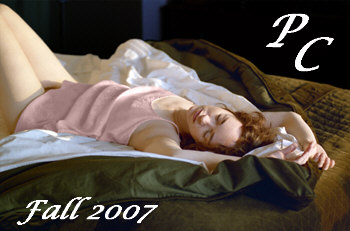

But the point here is to call attention to the inherent abstractness of Bourgeois’s work. Her sculptures are intimately organic. Her concern with the nature of the human body--often as a sum of parts that add up to a inconclusive whole--signals her concern with human nature. “Man is a beast to man,” she once said, and many of her bodies have an archaic beastly character, as though they were animistic gods, like those the Egyptians worshipped. But for Bourgeois the body is a means to an expressive end even as it is a phenomenon in itself. It is the first ego, as Freud said, and the fundament of the egos we develop through our relationships. Her sculpture, with its changing visions of the body and elaboration of its parts, indicate that these egos leave their emotional mark on it. Bourgeois’s bodies pulse with raw emotion--they are a terrain of difficult feeling as well as the material fundament of being--indicating that hers is a “psychosomatic” art. Her bodies register the emotional storms and traumatic tensions of life, even as they heroically survive it, maintaining their integrity.
There is in fact something noble and heroic about the “totemic” figures Bourgeois created from ca. 1950-1980. Composed of fragments of painted wood, they nonetheless seem sturdy: they are like the vertebrae of a spine, as the metal rod that runs through them suggests. Thus they stand upright, their spirit unbroken however broken their bodies. They are self-portraits, but also portraits of modern humanity. They have a certain affinity with Giacometti¹s isolated figures, but they reveal a deeper grasp of the modern condition, for while Giacometti¹s bodies are melancholy and vulnerable, Bourgeois’s bodies are inherently problematic. Giacometti stays on the expressive exterior, Bourgeois articulates internal reality. I would even venture to say that Giacometti¹s distressed figures are emotionally one-dimensional compared to Bourgeois’s dialectical figures. Her bodies reveal what Heinz Kohut famously described as the narcissistic dialectic of modern man--always on the verge of falling apart, because of the lack of empathy and ideals in the world, he nonetheless manages to stay together, however precariously. Memling Dawn, ca. 1951 makes this very clear.
Now what is striking about Bourgeois’s figures from ca. 1950-1980 is their covert symmetry however overtly asymmetrical the arrangement of their parts. What looks outwardly unstable is in fact quite stable. Symmetry is important for Bourgeois, and often overt, as in Le Trani Episode and No Exit. It is an abstract constant of her work. The body is symmetrical, as Torso/Self-Portrait, ca. 1963-64 shows, and so are its parts, as Fillette, 1968 shows. Symmetry implies balance and mirroring, and thus the sameness of what seem opposed. It also defines a center; the steel axis of the early figures is their center. Symmetry creates structure; without it the body’s architecture would collapse into chaos. Even when Bourgeois’s sculptures seem chaotic, as in Number Seventy-Two (The No March), 1973—contrast this with the neatly arranged parts of the forties marching pieces--there is a certain “accent on the middle,” as Rudolf Arnheim calls it,
contributing to an effect of stability,(5) and suggesting a latent symmetry. Indeed, however differentiated by coloration and size, the seventy-two pieces mirror each other formally--they are modular in principle--if in what may seem like a distorting mirror. The cluster effect is deceptive. Geometrically contained, the densely packed repeated parts form a grid, as Fountain, ca. 1971 and Partial Recall, 1978 make explicit.
What we see in Bourgeois’s sculpture is a return to the fundamentals of abstraction, and with that the recognition that what Kandinsky called “the Great Abstraction” and “the Great Realism” are similar. As Kandinsky wrote, “the two poles equal one another...the greatest external dissimilarity becomes the greatest internal similarity.”(6) Bourgeois’s sculpture goes beyond this external dissimilarity and internal similarity: the external and internal--the objective and subjective--are completely integrated even as the tension between them is maintained. I think this--pushing to the extremes while maintaining their connection, so that the contradiction is simultaneously resolved and unresolved--is unprecedented in its radicality. “Reduced to a minimum”--a geometrical minimum in Bourgeois’s case—“’the artistic’ element...must be recognized as the most powerfully affective abstract element,” Kandinsky stated. Similarly, “reduced to a minimum,” the “’objective’ element--in Bourgeois’s case the organic body and its expressive parts—“must, in the case of abstraction, be recognized as the most powerfully affective real element.” Bourgeois’s sculptures fuse the powerfully affective real element that is the abstracted body and the powerfully affective abstract element that is geometrically real while acknowledging their difference. One might say that Bourgeois has collapsed the real into the abstract and the abstract into real, making each the unconscious of the other, and thus restoring uncanniness to both.
Notes
(1) William Rubin, “Louise Bourgeois: One and Others”, Louise Bourgeois (New York: Museum of Modern Art, 1982; exhibition
catalogue), p.15
(2) Robert Pincus-Witten, Postminimalism (New York: Out of London Press, 1977), p. 14
(3) Quoted in Herschel B. Chipp, ed., Theories of Modern Art (Berkeley: University of California Press, 1968), p. 93
(4) Rubin, p. 25
(5) Rudolf Arnheim, The Power of the Center: A Study of Composition in the Visual Arts (Berkeley: University of California Press, 1982), p.73
(6) “On The Question Of Form,” Kandinsky: Complete Writings on Art, ed. Kenneth C. Lindsay and Peter Vergo (New York: Da Capo Press, 1994), p. 245

Per Contra: The International Journal of the Arts, Literature and Ideas
The Real Abstract: Louise Bourgeois’s Sculpture by Donald Kuspit
PAGE 2